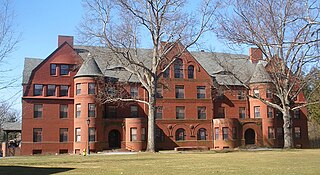Related Research Articles

Christopher Wolfgang Alexander is a widely influential British-American architect and design theorist, and currently emeritus professor at the University of California, Berkeley. His theories about the nature of human-centered design have affected fields beyond architecture, including urban design, software, sociology and others. Alexander has designed and personally built over 100 buildings, both as an architect and a general contractor.
A design pattern is the re-usable form of a solution to a design problem. The idea was introduced by the architect Christopher Alexander and has been adapted for various other disciplines, notably software engineering.
Software architecture refers to the fundamental structures of a software system and the discipline of creating such structures and systems. Each structure comprises software elements, relations among them, and properties of both elements and relations. The architecture of a software system is a metaphor, analogous to the architecture of a building. It functions as a blueprint for the system and the developing project, laying out the tasks necessary to be executed by the design teams.
In software engineering, a software design pattern is a general, reusable solution to a commonly occurring problem within a given context in software design. It is not a finished design that can be transformed directly into source or machine code. Rather, it is a description or template for how to solve a problem that can be used in many different situations. Design patterns are formalized best practices that the programmer can use to solve common problems when designing an application or system.
A pattern language is an organized and coherent set of patterns, each of which describes a problem and the core of a solution that can be used in many ways within a specific field of expertise. The term was coined by architect Christopher Alexander and popularized by his 1977 book A Pattern Language.
Software design is the process by which an agent creates a specification of a software artifact intended to accomplish goals, using a set of primitive components and subject to constraints. Software design may refer to either "all the activity involved in conceptualizing, framing, implementing, commissioning, and ultimately modifying complex systems" or "the activity following requirements specification and before programming, as ... [in] a stylized software engineering process."
The concept of design paradigms derives from the rather ambiguous idea of paradigm originating in the sociology of science, which carries at least two main meanings:

A Pattern Language: Towns, Buildings, Construction is a 1977 book on architecture, urban design, and community livability. It was authored by Christopher Alexander, Sara Ishikawa and Murray Silverstein of the Center for Environmental Structure of Berkeley, California, with writing credits also to Max Jacobson, Ingrid Fiksdahl-King and Shlomo Angel. Decades after its publication, it is still one of the best-selling books on architecture.
The Nature of Order: An Essay on the Art of Building and the Nature of the Universe (ISBN 0-9726529-0-6) is a four-volume work by the architect Christopher Alexander published in 2002–2004. In his earlier work, Alexander attempted to formulate the principles that lead to a good built environment as patterns, or recurring design solutions. However, he has come to believe that patterns themselves are not enough to generate life in buildings and cities, and that one needs a "morphogenetic" understanding of the formation of the built environment as well as a deep understanding of how the makers get in touch with the creative process.

The Oregon Experiment is a 1975 book by Christopher Alexander and collaborators Murray Silverstein, Shlomo Angel, Sara Ishikawa, and Denny Abrams. It describes an experimental approach to campus community planning at the University of Oregon, in Eugene, Oregon which resulted in a theory of architecture and planning described in the group's later published and better-known volumes A Pattern Language and The Timeless Way of Building.
Interaction design patterns are design patterns applied in the context human-computer interaction, describing common designs for graphical user interfaces.
An architectural pattern is a general, reusable solution to a commonly occurring problem in software architecture within a given context. The architectural patterns address various issues in software engineering, such as computer hardware performance limitations, high availability and minimization of a business risk. Some architectural patterns have been implemented within software frameworks.
Software analysis patterns or analysis patterns in software engineering are conceptual models, which capture an abstraction of a situation that can often be encountered in modelling. An analysis pattern can be represented as "a group of related, generic objects (meta-classes) with stereotypical attributes, behaviors, and expected interactions defined in a domain-neutral manner."

Nikos Angelos Salingaros is a mathematician and polymath known for his work on urban theory, architectural theory, complexity theory, and design philosophy. He has been a close collaborator of the architect Christopher Alexander, with whom Salingaros shares a harsh critical analysis of conventional modern architecture. Like Alexander, Salingaros has proposed an alternative theoretical approach to architecture and urbanism that is more adaptive to human needs and aspirations, and that combines rigorous scientific analysis with deep intuitive experience.

A Theory of Architecture is a somewhat controversial book on architecture by Nikos Salingaros, published in 2006 by Umbau-Verlag, Solingen, ISBN 3-937954-07-4. Glowing cover blurbs by Kenneth G. Masden II, Duncan G. Stroik, Michael Blowhard, and Dean A. Dykstra. Preface by Prince Charles, and Foreword by Kenneth G. Masden II. This book is a re-working of previously published articles used to teach a senior architecture studio class. Four of the twelve chapters were originally written in collaboration, and the co-authors include Michael Mehaffy, Terry Mikiten, Debora Tejada, and Hing-Sing Yu.
A debugging pattern describes a generic set of steps to rectify or correct a bug within a software system. It is a solution to a recurring problem that is related to a particular bug or type of bug in a specific context.

In the field of architecture an architectural plan is a design and planning for a building, and can contain architectural drawings, specifications of the design, calculations, time planning of the building process, and other documentation.

An architectural drawing or architect's drawing is a technical drawing of a building that falls within the definition of architecture. Architectural drawings are used by architects and others for a number of purposes: to develop a design idea into a coherent proposal, to communicate ideas and concepts, to convince clients of the merits of a design, to assist a building contractor to construct it based on design intent, as a record of the design and planned development, or to make a record of a building that already exists.
Object-oriented programming (OOP) is a programming paradigm based on the concept of "objects", which can contain data and code: data in the form of fields, and code, in the form of procedures.

Parametric design is a process based on algorithmic thinking that enables the expression of parameters and rules that, together, define, encode and clarify the relationship between design intent and design response.
References
- ↑ Alexander, Christopher (1977). A Pattern Language: Towns, Buildings, Construction . Oxford University Press, USA. p. 1216. ISBN 0-19-501919-9.